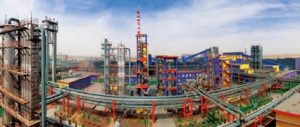Over the last two decades, awareness has grown that carbon capture and storage (CCS) could be an important technology in the fight to reduce greenhouse gas emissions; more than 20 large-scale demonstration projects are now in the pipeline. According a 2009 report from the International Energy Agency, CCS in the power and industrial sectors is likely to represent 10% of total emissions reductions by 2030.
As most major economies have already made a commitment to controlling greenhouse gas emissions, ideally no new fossil-fuel power plants, oil-refinery and steel plants or cement kilns would be permitted unless they were built with full-scale CCS facilities. Widespread deployment of large-scale CCS is, however, facing two major challenges: a lack of experience in building and operating commercial-scale integrated CCS projects and insufficient financial incentives to provide a fair return for investors. Before these challenges can be addressed, new fossil-fuel combustion plants in the next decade should be designed and built using the carbon capture ready (CCR) approach in order to ease retrofitting of CCS in the future.
Some stakeholders are concerned that CCS technologies are not yet proven because of a lack of industrial projects. This view is not entirely correct. More than 100 industrial CCS projects are being developed and about 20 are currently in operation, including the Statoil-Sleipner one million-tonne per year storage project in Norway, the 30 megawatt Vatternfall-Schwarze Pumpe pilot plant in Germany and the Huaneng-Gaobeidian 3000-tonne per year post-combustion capture pilot in China. A few projects have been running for more than 10 years.
The real issue is a lack of large-scale schemes. According to the United Kingdom’s Stern Review, capturing carbon dioxide from fossil-fuel power stations is essential to delivering steep cuts in emissions. But no existing CCS project is yet capturing carbon dioxide from power stations at a rate of more than one million tonnes per year.
The European Union hopes to have at least 10 demonstration projects up and running by 2015 and is preparing a knowledge-sharing framework for CCS, though the timetable appears to be slipping. The US energy secretary Steven Chu has announced a similarly ambitious target: the United States could have 10 to 12 commercial demonstration projects operational by 2016 and ready for a wider commercial deployment by 2019. The Australian government, meanwhile, is providing 100 million Australian dollars (US$90 million) per year for a Global Carbon Capture and Storage Institute (GCCSI) to support demonstration projects worldwide. And, while the Chinese government has not yet aggressively supported CCS demonstration projects, large state-owned energy companies such as Huaneng Group, GreenGen and Shenhua have proposed a number of large-scale schemes. Several bilateral and multilateral initiatives have also been established in order to accelerate the sharing of risk, funding and knowledge, including the Carbon Sequestration Leadership Forum, the FutureGen Alliance, and the UK-EU-China Near Zero Emissions Coal (NZEC) initiative plus the GCCSI.
Examples of three types of capture technology – post-combustion, pre-combustion, and separation from industrial process – are in commercial use for non-CCS applications. A fourth, oxy-fuel, is still in the pilot demonstration phase. However, more research and demonstration are needed to make “capture” economically feasible and technically proven at the scale, and under the conditions, required for CCS-relevant applications.
Once the carbon dioxide is captured, it has to be transported to a suitable and secure storage site – a pipeline is the most economic way to do this – and can then be injected into deep geological formations for storage. The oil and gas industry has experience injecting large quantities of carbon dioxide into saline formations and oil and gas fields and the technology is reasonably mature. Thus most CCS technologies are ready to deploy and have established suppliers. The priorities in their development are achieving cost reductions and demonstrating full-system integration.
So what are the costs? According to a study by energy consultancy Pöyry for the UK government, the abatement cost for carbon capture in 2015 is likely to be US$41 (280 yuan) to US$57 (389 yuan) per tonne of carbon dioxide for capturing from coal or natural-gas power stations, and the cost for storing and monitoring carbon dioxide in saline aquifer US$1.60 (10.9 yuan) to US$3.20 (21.8 yuan) per tonne of carbon dioxide. A special report on CCS from the Intergovernmental Panel on Climate Change suggests the cost of transportation is US$1 (6.8 yuan) to US$6 (41 yuan) per tonne for a 250 kilometre pipeline carrying five-million tonnes per year but the actual number is sensitive to location and land cost.
According to a study by consultant McKinsey & Company published in 2008, the total cost of initial CCS demonstration projects between 2012 and 2015 is likely be around US$84 (574 yuan) to US$127 (867 yuan) per tonne of carbon dioxide and reduce to US$49 (335 yuan) to US$70 (478 yuan) per tonne abated shortly after 2020. However, if a discount rate is applied to reflect the uncertainties in CCS investment, the cost goes up by US$13 (89 yuan) to US$15 (102 yuan) per tonne.
CCS in developing countries may have a cost advantage. The NZEC project and China-EU collaboration, COACH, suggest the full CCS costs could be US$35 (239 yuan) to US$42 (287 yuan) per tonne of carbon dioxide abated in large scale projects. However, this advantage may be much reduced in 2020 as labour costs, capital costs and currency value tend to rise faster in developing countries. An established CCS methodology in the Clean Development Mechanism (CDM) could potentially provide a substantial amount of financial support to kick-start early CCS demonstration projects in the developing world. However, support solely from CDM is not enough. Since carbon abatement costs in demonstration projects are much higher than the current market price of certified emissions reductions (CER), additional financial incentives from the public sector are likely to be the main driver for CCS demonstration projects around the world in the next decade.
The vast majority of global stakeholders share a consensus that CCS is an important technology for reducing greenhouse gas emissions. However, among the lay public, renewable and efficient appliances are perceived to be slightly more positive than CCS. The lack of awareness and information among policymakers and the general population has become a barrier in deploying CCS at scale.
The energy penalty is one limitation of CCS. Capturing and compressing carbon dioxide may increase the fuel needs of coal-fired power plants by more than 25%. Interestingly, most stakeholder consultations carried out in major developed economies have concluded that development of CCS will enhance energy security because a number of people in developed countries believe coal plants will not be permitted in the absence of CCS in the near future. However, Chinese stakeholders tend to frame CCS technologies as a threat to national energy security because they believe they could result in a higher import rate for coal. Some are also concerned about operational safety issues and coal-mining accidents.
Before CCS becomes economically feasible, power stations will continue to be built and emit carbon dioxide into the atmosphere. According to an IEA estimate, coal-fired generation is likely to grow by 2.5 times in China and 3.5 times in India during between 2007 and 2030. Modifications to make new plants carbon-capture ready are important for easing the retrofit of CCS. Developers of capture-ready plants should take responsibility for ensuring that all known factors in their control that would prevent installation and operation of carbon-dioxide capture have been identified and eliminated.
For pulverised-coal power plants, the carbon-capture ready investment is modest; less than 1% of the original fixed-capital expense, according to IEA estimates. However, it could reduce the possibility of early closure by 7% to 10% and increase the possibility of retrofitting by 5% to 7%, according to a 2009 study by the UK-China Chinese Advanced Power Plants Carbon Capture Option (CAPPCCO). A survey of 103 power plants in China by CAPPCO indicated nearly half of Chinese coal-fired power plants, none of which were built to be capture ready, would be unviable for retrofit.
The success of CCS will depend on a series of factors being realised. First, sufficient financial and political supports, plus explicit early-mover benefits, are needed to create an acceptable investment environment for demonstration projects. Second, such projects must prove the reliability and safety of CCS technologies and find efficient financial and operational models. Third, substantial cost reductions need to be achieved through technological innovation and the carbon price must become stable and high enough to justify CCS investment. And fourth, a more effective communication framework is necessary to improve the understanding of CCS among policymakers, energy entrepreneurs and the lay public.
Finally, once CCS becomes economically feasible, it should be possible to implement the technologies in every new fossil fuel plant and to retrofit some existing plants – with priority for those that were built to be carbon capture ready.
Li Jia is chief executive of LinksChina Investment Advisory Limited, founder of CaptureReady.com and a PhD candidate in mechanical engineering at Imperial College, London. Xi Liang is a research associate in the Electricity Policy Research Group at the University of Cambridge.
Hompage image from Vattenfall shows its Schwarze Pumpe oxyfuel pilot plant in Spremberg, Germany.



